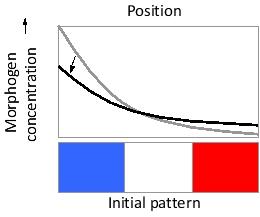Imagine a morphogen gradient established from left to right in a field of cells in a developing tissue, as shown in the following schematic diagram. Below a first threshold of morphogen concentration, cells do not respond to the morphogen and express gene "red" by default. Cells exposed to morphogen concentrations above this threshold respond by expressing gene "white" instead, while those exposed to even higher concentrations, above a second threshold, express gene "blue." As shown, the initial pattern resembles a French flag with equally wide blue, white, and red expression domains. With no other change, if the diffusion rate of the morphogen is increased (by a modification that decreases its affinity for heparan sulfate proteoglycans, for example), the gradient profile changes from the gray curve to the black curve, as indicated. Under this new condition, indicate whether each of the following would be expected to increase (I), decrease (D), or remain unchanged (U) in its range. Your answer would be a three-letter string composed of letters I, D, and U only, e.g. UUI.

( ) Blue expression domain
( ) White expression domain
( ) Red expression domain
Correct Answer:
Verified
D
Changes in parameters such as diffu...
View Answer
Unlock this answer now
Get Access to more Verified Answers free of charge
Q1: Indicate whether each of the following groups
Q2: Indicate true (T) and false (F) statements
Q3: In a developing Drosophila melanogaster embryo, a
Q4: Indicate true (T) and false (F) statements
Q6: Sort the following organisms from the least
Q7: Which of the following is correct regarding
Q8: The gene clusters known as the Bithorax
Q9: In Drosophila melanogaster, the expression of genes
Q10: Cortical rotation following fertilization in X. laevis
Q11: Indicate whether each of the following proteins
Unlock this Answer For Free Now!
View this answer and more for free by performing one of the following actions

Scan the QR code to install the App and get 2 free unlocks

Unlock quizzes for free by uploading documents